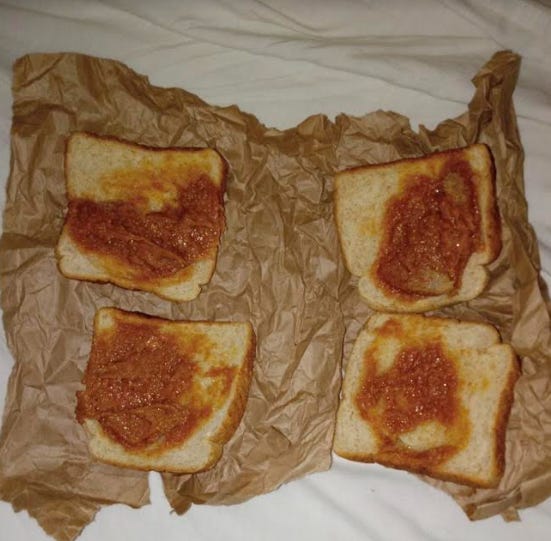The five most disgusting prison meals.
Are you brave enough to read about West Virginia’s semen-stained suppers?
Editor’s note: The following story is a guest post by Keri Blakinger. Check out her book, Corrections in Ink: A Memoir.
On my first morning in a maximum-security prison, I sat down at the mess hall table for breakfast and heard a whispered warning: “Check your bowl – a cock-a-roach crawled out of the cornflakes yesterday.” I glanced up at the stocky white woman who said it, trying to suss out whether her words were true – not because I doubted that there might be bugs in the food, but because I doubted they’d still be alive by the time we’d sat down and doused them in milk. Wanting to be sure, I jabbed my spoon at the bowl with my spoon before taking a bite, relieved to discover the only crunch was from the cornflakes.
Sometimes when I got my tray, I pulled long, dark hairs out of my soup or ate around small spots of mold. But looking back I think that early morning warning was about the worst food story I have from the two years I spent behind bars: One near-sighting of a single roach.
In retrospect, I realize I was lucky; I did my time in New York. After I got out in 2012, I moved to Texas, and eventually began covering prisons across the country – many of which have significantly worse culinary problems than a stray roach.
Usually, when I write about the appalling meals, I focus on the unidentifiable food or meager portions – the things you can show readers with leaked cell phone pictures. But there’s actually a whole variety of other ways in which prison cuisine can be appalling, some of which are harder to illustrate. Here, just in season for your holiday feast, is a round-up of five of the worst, weirdest and most appalling food problems I’ve encountered in my time reporting on prisons.
The Lone Star State’s Lousy Lunches
The first time I wrote about prison food was in early 2020. At that point, I’d already been hearing for a few years about how bad the bagged meals were in Texas prisons, but I couldn’t really prove it. After all, black-and-white descriptions of mold, roaches, or starvation portions of goop just don’t make for viscerally shocking stories – unless you have pictures to back them up.
But then the pandemic hit. Dozens of prisons went into lockdown, shuttering the mess halls and forcing prisoners to eat bagged meals in their cells. Then, as people began falling ill, more and more staff stopped showing up for work and conditions deteriorated. Eventually, a handful of desperate prisoners with contraband phones started documenting the conditions, passing along pictures of the piss-poor food.
Some of the images showed “sloppy joes” that looked like diarrhea on wheat bread, and others showed greenish hot dogs, burnt pancakes and moldy peanut butter sandwiches. There were no fresh fruits or vegetables to be seen – unless you count the one time they handed out an entire raw onion along with dinner.
For months, this was how life continued, and time and again prisoners sent out images of it. At one point, conditions improved for several weeks following my initial reporting, and incarcerated people sent images of bananas and broccoli and other fresh produce they hadn’t seen in years. But in many places, the food returned to terrible until the lockdowns ended and the mess halls opened – at which point it returned to lukewarm terrible.
Alabama’s Two-a-Days
The Alabama prison system is in famously poor shape. After years of escalating violence and deteriorating conditions, the U.S. Department of Justice filed suit in 2020, saying things had gotten so bad it was unconstitutional.
Two years later, the investigation is still ongoing – and conditions have not improved. That’s why, this fall, Alabama prisoners went on strike. They issued a set of demands – mostly reforms that could help some of them at least go home earlier, since conditions weren’t getting any better – and refused to go to their jobs in mess halls, laundry rooms, prison factories and call centers.
In response, prison officials cut back on food. The portions got smaller and instead of the usual three meals a day, men at the striking facilities got only two. In many prisons, two meals a day is the norm for weekends and holidays when there may be fewer staff around to supervise – but only allowing people to eat twice a day for days on end is not supposed to be the norm anywhere.
Predictably, Alabama prisoners took it to court, saying that the state was endangering prisoners with diabetes and other medical conditions by “bird-feeding” them to force an end to the strike. (Corrections department officials predictably denied this, instead blaming the prisoners. The reduced feeding schedule, they said, was not about retaliation but instead about practicality, since the usual mess hall workers were taking part in the labor strike.)
Keep reading with a 7-day free trial
Subscribe to Substance to keep reading this post and get 7 days of free access to the full post archives.





